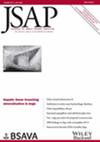Successful conservative management of urinary tract rupture in dogs and cats: 52 cases (2003-2024)
Abstract
Objectives
To describe the successful conservative management of urinary tract ruptures in dogs and cats.
Materials and Methods
Medical records of a hospital between 2003 and 2024 were reviewed to identify dogs and cats with urinary tract rupture. Cases were included if they were successfully managed conservatively (including only procedures that did not directly address the site of rupture). Data recorded included signalment, cause and location of rupture, method and duration of urinary diversion, outcome and complications.
Results
Fifty-two cases (40 cats and 12 dogs) were included. The most common causes of rupture were trauma associated with urethral obstruction and catheterisation (18), cystocentesis (17) and external trauma (8). The most common sites of rupture were the urethra (20 cats and five dogs) and urinary bladder (15 cats and four dogs). Bladder ruptures were most commonly managed with urethral catheters and/or peritoneal drains, while urethral ruptures were most commonly managed with urethral catheters and/or cystostomy tubes. The median (range) time to resolution of urine leakage documented on imaging was 3 (1 to 6) days for bladder ruptures and 6.5 (3 to 28) days for urethral ruptures. Radiographic evidence of urethral narrowing was documented in 11/25 cases with urethral tears at a median (range) of 12 (4 to 28) days post-rupture. Urine culture was performed in 22/52 cases with urinary tract ruptures and was positive in 14 cases.
Clinical Significance
Conservative management can be considered in both iatrogenic and traumatic urinary tract ruptures. The risk of urethral strictures and urinary tract infections should be considered when electing for conservative management of urinary tract ruptures.


 求助内容:
求助内容: 应助结果提醒方式:
应助结果提醒方式:


